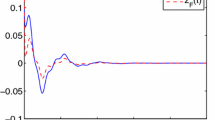Abstract
This paper presents an H ∞ robust fuzzy control strategy which stabilizes singularly perturbed (SP) nonlinear systems with bounded uncertainties and guarantees disturbance attenuation bounds for all admissible uncertainties. The modified Takagi–Sugeno (T–S) fuzzy linear models are used to describe the SP nonlinear systems. By the proposed fuzzy control strategy, the number and type of membership functions in the fuzzy control rules are not necessarily the same as those in the fuzzy models. A sufficient condition for the existence of the H ∞ robust fuzzy controllers is then presented in terms of a novel linear matrix inequalities (LMIs) form which takes full consideration of modeling error and uncertainties in system parameters. This condition provides extra design parameters with more flexibility in control gain selection. Furthermore, we propose a compound search strategy composed of island genetic algorithms concatenated with the simplex method to identify the uncertain SP nonlinear systems for the fuzzy control design, and to solve the LMI problem. Finally, design example of the proposed H ∞ robust fuzzy controller for an uncertain SP nonlinear system is presented.
Similar content being viewed by others
References
Tseng CS and Chen BS (2001). H ∞ decentralized fuzzy model reference tracking control design for nonlinear interconnected systems. IEEE Trans Fuzzy Syst 9: 795–809
Assawinchaichote W and Nguang SK (2006). Fuzzy H ∞ output feedback control design for singularly perturbed systems with pole placement constraints: an LMI approach. IEEE Trans Fuzzy Syst 14: 361–371
Lee KR, Jeung ET and Park HB (2001). Robust fuzzy H ∞ control for uncertain nonlinear systems via state feedback: an LMI approach. Fuzzy Sets Syst 120: 123–134
Tanaka K, Ikeda T and Wang HO (1998). Fuzzy regulators and fuzzy observers: relaxed stability conditions and LMI-based designs. IEEE Trans Fuzzy Syst 6: 250–265
Li TS and Lin KJ (2004). Stabilization of singularly perturbed fuzzy systems. IEEE Trans Fuzzy Syst 12: 579–595
Assawinchaichote W and Nguang SK (2004). H ∞ filtering for fuzzy singularly perturbed systems with pole placement constraints: an LMI approach. IEEE Trans. Signal Process Speech Signal Process 52: 1659–1667
Malki HA, Misir D, Feigenspan D and Guanrong C (1997). Fuzzy PID control of a flexible-joint robot arm with uncertainties from time-varying loads. IEEE Trans Control Syst Technol 5: 371–378
Chang YZ and Daniel RW (1992). On the adaptive control of flexible joint robots. Automatica 28: 969–974
Thompson MT (2000). Electrodynamic magnetic suspension-models, scaling laws and experimental results. IEEE Trans Educ 43: 336–341
Shao ZH (2004). Robust stability of two-time-scale systems with nonlinear uncertainties. IEEE Trans Autom Control 49: 258–261
Kokotovic PV, Khalil HK and O’Reilly J (1986). Singularly perturbation methods in control: analysis and design. Academic, New York
Liu H, Sun F and Sun Z (2005). Stability analysis and synthesis of fuzzy singularly perturbed systems. IEEE Trans Fuzzy Syst 13: 273–284
Tong S and Li HH (2002). Observer-based robust fuzzy control of nonlinear systems with parametric uncertainties. Fuzzy Sets Syst 131: 165–184
Chang YZ, Chang J and Huang CK (1999). Parallel genetic algorithms for a neurocontrol problem. Int Joint Conf Neural Netw 6: 4151–4155
Nelder JA and Mead R (1965). A simplex method for function minimization. Comput J 7: 308–313
Chen BS, Tseng CS and Uang HJ (1999). Robustness design of nonlinear dynamic systems via fuzzy linear control. IEEE Trans Fuzzy Syst 7: 571–585
LaSalle JP (1960). Some extensions of Lyapunov’s second method. IRE Trans Circuit Theory 7: 520–527
Gahinet P, Nemirovski A, Laub A and Chilali M (1995). LMI Control Toolbox. The Math Works, Natick
Author information
Authors and Affiliations
Corresponding author
Rights and permissions
About this article
Cite this article
Chang, YZ., Tsai, ZR., Hwang, JD. et al. Robust fuzzy control and evolutionary fuzzy identification of singularly perturbed nonlinear systems with parameter uncertainty. Electr Eng 90, 379–393 (2008). https://doi.org/10.1007/s00202-007-0085-z
Received:
Accepted:
Published:
Issue Date:
DOI: https://doi.org/10.1007/s00202-007-0085-z




